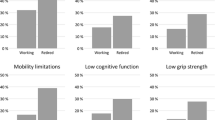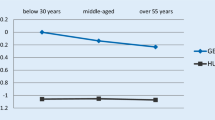Abstract
Background
An increasing number of persons continue to work after retirement age. This decision is often different between men and women as well as working histories, sectors and hierarchical positions; however, whether gender differences in working conditions and occupational well-being also exist in paid employment after retirement (PEAR) has not yet been investigated.
Objective
This study aimed to examine gender differences in working conditions and well-being of workers in PEAR.
Material and methods
In this study 784 employees (23.5% female) aged 65 years and older who were contracted by a Dutch temporary employment agency, participated in the baseline survey in 2011. Furthermore, a panel of 228 employees (25.9% female) participated again during a second wave in 2012. Job demands, job control, emotional exhaustion and job engagement were assessed at both time points by validated self-reporting measures.
Results
Female employees worked fewer years in paid employment before 65 years of age, were more likely to be single, divorced or widowed, had a smaller income and worked less hours during PEAR than men. In the baseline analysis, females reported less job control and higher job stress than men. No gender differences were found on emotional exhaustion, engagement or job demands. Over the study period emotional exhaustion only increased in females. The longitudinal trend of job demands, control and engagement did not significantly differ between both sexes.
Conclusion
The results suggest that working conditions of PEAR are less favorable for women than for men. Furthermore, the longitudinal trend of emotional exhaustion seems to be more disadvantageous for women.
Zusammenfassung
Hintergrund
Immer mehr Personen bleiben auch nach Renteneintritt erwerbstätig. Diese Entscheidung ist oft geschlechtsabhängig und, obwohl sich Männer und Frauen bezüglich Erwerbsbiografie, Arbeitsbranche und Position oft voneinander unterscheiden, gibt es bislang keine Studie zu geschlechtsspezifischen Unterschieden hinsichtlich Arbeitsbedingungen und Wohlbefinden bei Erwerbstätigkeit nach Renteneintritt.
Fragestellung
Ziel der Studie ist die Untersuchung geschlechtsspezifischer Unterschiede bezüglich psychosozialer Arbeitsbedingungen und Wohlbefinden bei Erwerbstätigkeit nach Renteneintritt.
Material und Methoden
An der ersten Befragungswelle 2011 nahmen 784 Angestellte einer niederländischen Zeitarbeitsagentur für Beschäftigte über 65 Jahre (23,5 % weiblich) teil. Ein Jahr später konnten 228 Teilnehmer (25,9 % weiblich) erneut befragt werden. Sozioökonomische Variablen, Anforderungen, Kontrolle und Engagement bei der Arbeit sowie emotionale Erschöpfung wurden mithilfe validierter Selbstbeurteilungsskalen erhoben.
Ergebnisse
Frauen waren weniger Jahre vor ihrem 66. Lebensjahr erwerbstätig, häufiger ledig, verwitwet oder geschieden, hatten ein geringeres Einkommen und arbeiteten weniger Stunden während ihrer Beschäftigung nach Renteneintritt als Männer. Zur ersten Befragungswelle gaben Frauen weniger Kontrolle und höhere Arbeitsbelastungen an. Bezüglich emotionaler Erschöpfung, Anforderungen und Engagement wurden keine signifikanten Unterschiede verzeichnet. Über den Studienverlauf nahm die emotionale Erschöpfung nur bei den Frauen zu. Es wurden keine weiteren signifikanten geschlechtsspezifischen Veränderungen beobachtet.
Schlussfolgerung
Die Ergebnisse weisen auf ungünstigere Arbeitsbedingungen bei Erwerbstätigkeit nach Renteneintritt für Frauen hin. Des Weiteren nahm das Wohlbefinden bei der Arbeit über den Studienverlauf bei Frauen einen ungünstigeren Verlauf.



Similar content being viewed by others
References
Ahlin JK, Westerlund H, Griep Y, Magnusson Hanson LL (2018) Trajectories of job demands and control: risk for subsequent symptoms of major depression in the nationally representative Swedish Longitudinal Occupational Survey of Health (SLOSH). Int Arch Occup Environ Health 91:263–272
Ardito C, d’Errico A, Leombruni R (2014) Exposure to psychosocial factors at work and mental well-being in Europe. Med Lav 105:85–99
Beehr TA, Bennett MM (2014) Working After Retirement: Features of Bridge Employment and Research Directions. Work Aging Retire 1:112–128
Bijlsma I, Fouarge D, Montizaan R (2017) Werken met een AOW. Omvang, beweegredenen en risico’s van verdringing. Netspar Ind Pap Ser 69:1–57 (opinion paper)
Bosma H, Marmot MG, Hemingway H, Nicholson AC, Brunner E, Stansfeld SA (1997) Low job control and risk of coronary heart disease in Whitehall II (prospective cohort) study. Br Med J (Clin Res Ed) 314:558–565
Campos-Serna J, Ronda-Perez E, Artazcoz L, Moen BE, Benavides FG (2013) Gender inequalities in occupational health related to the unequal distribution of working and employment conditions: a systematic review. Int J Equity Health 12:57
Couper MP, Kapteyn A, Schonlau M, Winter J (2007) Noncoverage and nonresponse in an Internet survey. Soc Sci Res 36:131–148
Finch N (2014) Why are women more likely than men to extend paid work? The impact of work–family life history. Eur J Ageing 11:31–39
Ganzeboom HBG, De Graaf PM, Treiman DJ (1992) A standard international socio-economic index of occupational status. Soc Sci Res 21:1–56
Hedge JW, Borman WC (2012) The Oxford handbook of work and aging. Oxford University Press, New York
Henkens K, Leenders M (2010) Burnout and older workers’ intentions to retire. Int J Manpow 31:306–321
Henkens K, Van Solinge H (2014) Bridge employment in the Netherlands: who, what and why? In: Bridge employment: a research handbook. Routledge, New York, pp 27–50
Hofäcker D, Naumann E (2015) The emerging trend of work beyond retirement age in Germany. Z Gerontol Geriatr 48:473–479
Horn JE, Taris TW, Schaufeli WB, Schreurs PJ (2010) The structure of occupational well-being: a study among Dutch teachers. J Occup Organ Psychol 77:365–375
Karasek RA (1979) Job demands, job decision latitude, and mental strain: implications for job redesign. Adm Sci Q 24:285–308
Karasek R, Brisson C, Kawakami N, Houtman I, Bongers P, Amick B (1998) The Job Content Questionnaire (JCQ): an instrument for internationally comparative assessments of psychosocial job characteristics. J Occup Health Psychol 3:322–355
Lange AH de, Taris TW, Kompier MA, Houtman IL, Bongers PM (2003) “The very best of the millennium”: longitudinal research and the demand-control-(support) model. J Occup Health Psychol 8:282–305
Larsen M (2008) Does quality of work life affect men and women’s retirement planning differently? Appl Res Qual Life 3:23–42
Mäkikangas A, Kinnunen U, Feldt T, Schaufeli W (2016) The longitudinal development of employee well-being: a systematic review. Work Stress 30:46–70
Melamed S, Shirom A, Toker S, Berliner S, Shapira I (2006) Burnout and risk of cardiovascular disease: evidence, possible causal paths, and promising research directions. Psychol Bull 132:327–353
Micheel F, Roloff J, Wickenheiser I (2011) The impact of socioeconomic characteristics on older employees’ willingness to continue working in retirement Age. Comp Popul Stud 35:833–868
Muhonen T, Torkelson E (2003) The demand-control-support model and health among women and men in similar occupations. J Behav Med 26:601–613
Müller A, De Lange A, Weigl M, Van der Heijden B, Ackermans J, Wilkenloh J (2015) Task performance among employees above age 65: the role of cognitive functioning and job demand-control. Work Aging Retire 1:296–308
Niedhammer I, Sultan-Taieb H, Chastang JF, Vermeylen G, Parent-Thirion A (2012) Exposure to psychosocial work factors in 31 European countries. Occup Med (Lond) 62:196–202
Purvanova RK, Muros JP (2010) Gender differences in burnout: a meta-analysis. J Vocat Behav 77:168–185
Schaufeli WB, Van Dierendonck D (1993) The construct validity of two burnout measures. J Organ Behav 14:631–647
Schaufeli WB, Leiter MP, Maslach C, Jackson SE (1996) Maslach Burnout Inventory-General Survey (MBI-GS). In: Maslach C, Jackson SE, Leiter MP (eds) Maslach Burnout Iventory Manua, 3rd edn. Consulting Psychologists Press, Palo Alto
Schaufeli WB, Salanova M, González-Romá V, Bakker AB (2002) The measurement of engagement and burnout: a two sample confirmatory factor analytic approach. J Happiness Stud 3:71–92
Schaufeli WB, Bakker AB, Salanova M (2006) The measurement of work engagement with a short questionnaire. Educ Psychol Meas 66:701–716
Sekine M, Tatsuse T, Kagamimori S, Chandola T, Cable N, Marmot M, Martikainen P, Lallukka T, Rahkonen O, Lahelma E (2011) Sex inequalities in physical and mental functioning of British, Finnish, and Japanese civil servants: role of job demand, control and work hours. Soc Sci Med 73:595–603
Smith B, Smith TC, Gray GC, Ryan MA (2007) When epidemiology meets the Internet: web-based surveys in the Millennium Cohort Study. Am J Epidemiol 166:1345–1354
Verhofstadt E, Baillien E, Verhaest D, De Witte H (2017) On the moderating role of years of work experience in the Job Demand–Control model. Econ Ind Democr 38:294–313
Wang M, Zhan Y, Liu S, Shultz KS (2008) Antecedents of bridge employment: a longitudinal investigation. J Appl Psychol 93:818–830
Acknowledgements
We thank Bart Veltman and the Dutch temporary employment agency for workers above 65 years of age for their help with data collection.
Author information
Authors and Affiliations
Corresponding author
Ethics declarations
Conflict of interest
J. Weber, A. de Lange and A. Müller declare that they have no competing interests.
All procedures performed in studies involving human participants were in accordance with the ethical standards of the institutional and/or national research committee and with the 1975 Helsinki declaration and its later amendments or comparable ethical standards. Informed consent was obtained from all individual participants included in the study.
The supplement containing this article is not sponsored by industry.
Caption Electronic Supplementary Material
391_2018_1453_MOESM1_ESM.pdf
Supplemental Material 1 Drop-out analysis for all participants, male participants and female participants with data from wave 1
Rights and permissions
About this article
Cite this article
Weber, J., de Lange, A. & Müller, A. Gender differences in paid employment after retirement. Z Gerontol Geriat 52 (Suppl 1), 32–39 (2019). https://doi.org/10.1007/s00391-018-1453-1
Received:
Revised:
Accepted:
Published:
Issue Date:
DOI: https://doi.org/10.1007/s00391-018-1453-1




